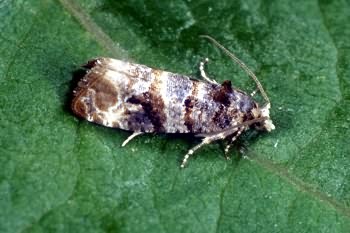Pests
Lobesia botrana (Den. et Schiff.) - European vine moth, Vine moth, Grape moth, Grapevine moth, Mediterranean vine moth, European grape berry moth
Systematic position.
Class Insecta, order Lepidoptera, family Tortricidae, subfamily Olethreutinae, genus Lobesia.Synonyms.
Polychrosis vitisana Jacq., Eudemis botrana Schiff.Biological group.
Pests of grape.Morphology and biology.
Adult with brown forewings that have distinctive pattern composed of light cross-section strips with yellowish and metal dark blue spots; wingspan 11-15 mm. Chlorinus larva with dark head grows up to 12 mm. Develops 2-4 generations per year; in the south of the USSR (Moldova, Ukraine, Dagestan, Transcaucasia) three generations, and the third is often incomplete; in Azerbaijan, Turkmenia, Tajikistan up to 4 generations. In zone of three generations the first one usually develops during May-June, the second in July-August, and the third from August until May. Diapausing pupae overwinter within flimsy silky cocoons allocated diffusively along the grape bush though the majority is concentrated in fractures of cortex in the inferior part of trunk. Grape is the major host plant, however larvae are rather polyphagous and in addition to cultural and wild grape can cause damage to blackberry, currant, cornel, hawthorn, sloe, and privet; larvae also feed on sumac, magnolia, clematis, daphna, and other plants, including apple fruit drop. Biological heterogeneity is shown within geographic range which has respect to composition of sex pheromone, terms of development, and other biological parameters. North border of geographic range was substantially determined according to conditions of hibernation (for overwintering pupae even short temperature drops below -20°C are destructive) and bounded by absolute winter minimums of -15°C. South border of insect range is limited by high temperatures (32°C) and low relative humidity of air (30%) during adult flight and development of eggs, and also absence of conditions for diapause removal while overwintering (warm winters with temperature limits of 5-15°C).Distribution.
The European part of former USSR: Moldova, Ukraine, North Caucasus; Lower Volga; Transcaucasia, Kazakhstan, Central Asia. South and Middle Europe (north to England), North Africa, Asia Minor, Middle East, Iran, Iraq; Japan (probably confused with close L. aeolopa). Deliveries into Finland were noted occasionally. Close species L. viteana inhabits North America.Ecology.
Overwintered adults start to fly after 10 days during which the daily average temperature stay at a level of 14.5°C, usually from third decade of April (Crimea, Zakarpatska Region of Ukraine), or in first half of May (Ukraine, Dagestan), and even from the beginning of April (Azerbaijan) which coincides with the phase of turgescence or expanding of grape buds. Flying periods of subsequent generations usually overlap and flight proceeds until October. Adults demonstrate activity at twilight, in the afternoon and at a dawn with temperature 15-32°C; lower threshold of activity is 11-13°C. Oviposition starts 3-5 days after adult emergence from pupa. Adult lays 60-160 (80 on average) eggs one by one, rarely in clusters of 2-5 eggs onto inflorescences, buds and leaves. The lower threshold of oviposition is 15°C, optimum is 20-27°C. Embryonic development at temperature 17-20°C lasts 9-10 days, at temperature 24-16°C for 4-7 days. Direct sunshine, high temperatures and low humidity of air are destructive for eggs. Hatching of 1st generation larvae usually coincides with the beginning of blossom of early grape varieties in Moldova, Ukraine, and Daghestan and usually occurs in 3rd decade of May and the beginning of June. Initially larvae damage buds and ovaries separately from surface, then spin neighboring ovaries into a web forming nidus. Each larva is capable of causing damage to 40-60 buds, flower or ovaries. The damaged parts of plants grow brown, dry up and shed. Pupation occurs both on bunches of unripe berries and on leaves and trunks under bark. The larva develops in 18-24 days, pupa in 10-12 days. Adults of 2nd and 3rd generations lay eggs mainly on unripe berries. Larvae of 1st and 2nd instar feed openly, then gnaw out around foramens and penetrate inside berries. After each molting larva migrates to the nearest berry it spins it into earlier parts damaged by web. The pupation of overwintering generation occurs mainly on trunks. Insect numbers and pest harm depend on microclimatic and weather conditions, as well as on activity of about 100 parasite species attacking eggs, larvae and pupae.Economic importance.
The second pest of grapes according to its economic value after phylloxera in all areas of wine growing, especially in southern region from Moldova up to Uzbekistan and Tajikistan. Crop losses from the pest can compound 30-70% and may reach up to 80% (Uzbekistan, Azerbaijan). Control measures: agrotechnical (increase ventilation of bushes, removal of old bark, cultivation of less damaged varieties), chemical, application of sex attractants for the purposes of pest forecasting, monitoring and getting male vacuum, biological (release of Trichogramma).Related references.
Aliev, A.G., Bashirov, F.B., Blagonravov, P.P., Gukasov, A.I., Zakharova, E.I., Kolesnik, L.V., Komarova, E.S., Korneichuk, V.D., Krupennikov, A.M., Kuzmin, A.J., Lazarjan, V.M., Lukyanov, A.D., Makarov-Kozhuhov, L.N., Makarov, I.F., Makarov S.N., Malhasyan, M.A., Mesyatseva, L.V., Mishurenko, A.G., Natsvin, A.V., Negrul, A.M., Oleinik, L.F., Palamarchuk, G.D., Panamarchuk, V.I., Pirusskii, V.V., Ruzaev, K.S., Saburov, N.V., Skuin, K.P., Soloviev, A.K., Sosina, E.I., Tabidze, D.I., Turyanskii, G.F., Tsetlin, M.G. 1959. Textbook of enologist. Moscow: State Publishing House Agric. lit., 626 p.(in Russian).Vasil'ev, V.P., ed., 1973. The pests of agricultural crops and forest plantations. V. 2. Kiev: Urozhai. 606 p. (in Russian).
Dobrodeyev, A.I. 1915. Grape leaf rollers, the European grape berry moth (Clysia [Cochylis] ambiguella Huebn.) and grape moth (Polychrosis botrana Schiff.) and measures of their control according the newest researches. - Proc. Bureau on entomology of Scientific Committee Agric. V. 11. No 5. p. 37. (In Russian).
Kuznetsov, V.I., ed. 1994. Insects and mites - pests of agricultural plants. V. 3(1). Lepidoptera. St. Petersburg: Publishing House "Nauka", 316 p. (in Russian).
Shchegolev, V.N. 1960. Agricultural entomology. Moscow-Leningrad: State Publishing House Agric. lit., 448 p. (In Russian)
Schmidt, K., Hoppmann, D., Holst, H., Berkelmann-Lohnertz, B. 2003. Identifying weather-related covariates controlling grape berry moth dynamics. Bull. OEPP. V. 33. P. 517-524.


